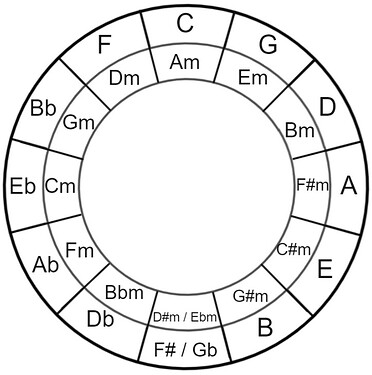For ease, we will look just at the C major and C minor parallel keys to begin.
Notice right away that clustered diatonic chords in the key of C major and the clustered diatonic chords in the key of C minor are in directly adjacent positions on the Circle of Fifths. The root note of the Major key is on the outer wheel, the root of the minor key is on the inner wheel.
Remember from earlier, in the key of C major, those six clustered chords represent the diatonic chords I through to vi. Around the outer wheel are the major chords IV, I, V (F, C, G) and around the inner wheel are the minor chords ii, vi, iii (Dm, Am, Em).
We also briefly saw that, viewed from the minor key perspective, the diatonic ordering changes. Looking at the key of C minor we would have on the outer wheel the majors VI, III, VII (Ab, Eb, Bb) and on the inner wheel the minor chords iv, I, v (Fm, Cm, Gm).
Considering the diminished chords for a moment (although we will not be using them), remember how we saw that their root notes sit along the diameter on the opposite side of the circle to the even numbered chords? In the key of C major, the note B (root of B diminished) is directly opposite the ii and IV chords of Dm and F. In the key of C minor, the note D (root of D diminished) is directly opposite the iv and VI chords of Fm and Ab.
We are going to push on in our exploring and begin to operate with two adjacent clusters of six chords from C major and C minor using the concept of borrowing chords. What we now have is an effective doubling of the number of chords available to us in creating chord progressions.
There is a small note of caution. In an introductory, it can be sensible to make sure that the borrowed chords are used sparingly, as little add-ins to complement and take a diatonic to a different sonic space for a brief moment, So the borrowed chord examples we will see will have just a single bar of a borrowed chord surrounded by diatonic chords.


